

Mixed hedges are a composition of various shrubs. Each species brings its own enticing highlight, either in sync or one at a time. Changing leaf colors, spread-out blooms, and decorative fruits – all such traits are worth considering. Autumn? That’s your go-to season for planting. To guide you in choosing, let’s take a look at combinations of shrubs selected for their winter interest.
Flowering hedge or country-style, this type of hedges brings a lot of natural charm to your garden. Why? Because shrubs can grow freely, and because of accompanying biodiversity. These hedges are low maintenance (a single light trimming per year). They also encourage wildlife by offering cover and food in the form of nectar, pollen, or fruits. They attract helpful insects that feed on garden pests. This helps limit parasite attacks without the need for treatments.
To create a sufficiently opaque curtain:
Planning an attractive hedge, even in winter? Mix up some spring or summer shrubs with these: Photinia, Prunus, Forsythia, Spiraea…
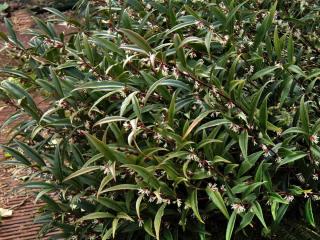 Get acquainted with Sarcococca hookeriana var digyna ‘Purple Stem’. It’s a Himalayan shrub with elliptical, evergreen foliage. Sporting a glossy dark green color, it stands tall at approximately 5 ft (1.50 m) with a generous spread of 6+ ft (2 m). At the heart of winter, its slightly arched, purple twigs are loaded with cream-colored flowers, which are tiny but very fragrant. The pollen sacks (anthers) turn red as they mature. This Sarcococca has a taste for cool climates and well-drained soil. It’s also comfortable in dense shade, making it perfect for planting at foot of a tree.
Get acquainted with Sarcococca hookeriana var digyna ‘Purple Stem’. It’s a Himalayan shrub with elliptical, evergreen foliage. Sporting a glossy dark green color, it stands tall at approximately 5 ft (1.50 m) with a generous spread of 6+ ft (2 m). At the heart of winter, its slightly arched, purple twigs are loaded with cream-colored flowers, which are tiny but very fragrant. The pollen sacks (anthers) turn red as they mature. This Sarcococca has a taste for cool climates and well-drained soil. It’s also comfortable in dense shade, making it perfect for planting at foot of a tree.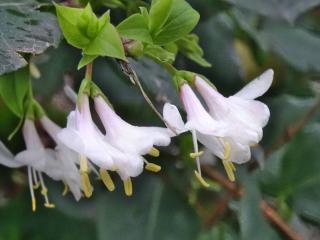 Next up is winter honeysuckle, Lonicera fragrantissima. Its lemony scent is beyond powerful. This big fellow stretches to 8+ ft (2.50 m) tall. Its oval leaves persist in mild climates. You’ll see clusters of creamy-white bells all along the branches from December to March. It’s very accepting of pruning after blooming and grows in all types of soil. Bring some indoors and watch the branches bloom in a vase!
Next up is winter honeysuckle, Lonicera fragrantissima. Its lemony scent is beyond powerful. This big fellow stretches to 8+ ft (2.50 m) tall. Its oval leaves persist in mild climates. You’ll see clusters of creamy-white bells all along the branches from December to March. It’s very accepting of pruning after blooming and grows in all types of soil. Bring some indoors and watch the branches bloom in a vase!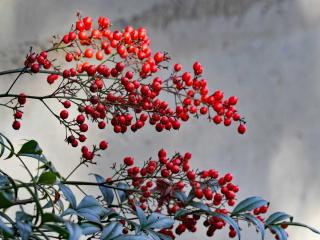 Say hello to Nandina domestica. This 5 ft (1.50 m) tall shrub has narrow, pointy leaflets that are doubly interesting in winter. Come November, it sports numerous bright red clusters. Moreover, its evergreen foliage takes on a coppery hue in cold weather, especially for the ‘Fire Power’ cultivar. Its white panicle blossoms in July add to its charm. Plant nandina domestica in rich, well-drained soil that’s not overly chalky.
Say hello to Nandina domestica. This 5 ft (1.50 m) tall shrub has narrow, pointy leaflets that are doubly interesting in winter. Come November, it sports numerous bright red clusters. Moreover, its evergreen foliage takes on a coppery hue in cold weather, especially for the ‘Fire Power’ cultivar. Its white panicle blossoms in July add to its charm. Plant nandina domestica in rich, well-drained soil that’s not overly chalky.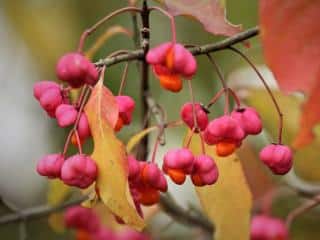 Meet European spindle, Euonymus europaeus ‘Red Cascade’, aka the priest’s cap. It got this nickname from its small, fuchsia-colored fruits that come in four angles. They open up to reveal big coral red seeds. When leaves turn garnet hues, it’s a total stunner! It thrives in chalky or limestone soils in underwood.
Meet European spindle, Euonymus europaeus ‘Red Cascade’, aka the priest’s cap. It got this nickname from its small, fuchsia-colored fruits that come in four angles. They open up to reveal big coral red seeds. When leaves turn garnet hues, it’s a total stunner! It thrives in chalky or limestone soils in underwood.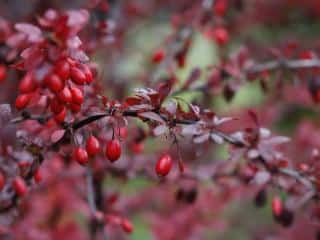 Adding in a few touches of rich, velvety violet colors is easy with Berberis thunbergii ‘Atropurpurea’. This barberry variety is a semi-evergreen variety: its leaves shift to a wonderful bright orange hue and then to deep red, before falling off in fall. It grows 6 feet (2m) tall, but you can easily keep it shorter in stature with regular pruning. This shrub doubles as an intruder barrier thanks to 3 spikes that grow at the base of each leaf. It copes well with all kinds of soil.
Adding in a few touches of rich, velvety violet colors is easy with Berberis thunbergii ‘Atropurpurea’. This barberry variety is a semi-evergreen variety: its leaves shift to a wonderful bright orange hue and then to deep red, before falling off in fall. It grows 6 feet (2m) tall, but you can easily keep it shorter in stature with regular pruning. This shrub doubles as an intruder barrier thanks to 3 spikes that grow at the base of each leaf. It copes well with all kinds of soil.